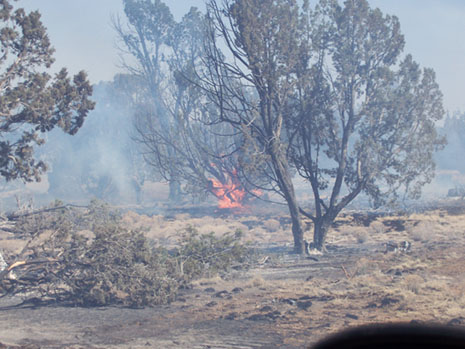Fire is a critical aspect of ponderosa pine and pinyon-juniper (P-J) woodland areas such as the Beaver Creek watershed. Historically, frequent, low-intensity fire has been a normal process within the ponderosa and P-J ecosystems of the Colorado Plateau region. However, fire suppression efforts of the 20th century resulted in ponderosa and P-J woodlands that are more densely populated and now undergo intense burning during wildfires. The less frequent, more intense wildfires that now occur have the potential to be much more catastrophic than fires have historically been in the area.

A burning juniper bush on the Colorado Plateau; Knife fire, May 2006
Fire and the Beaver Creek Watershed
Among the many effects extreme fire events have
on ponderosa and P-J watersheds is that of hardening
soils, resulting in increased slope erosion and headwater
channel scouring. This, in turn, causes increased
flooding and sedimentation in downstream channels.
Increased sedimentation can cause streambanks to
widen and streambeds to shallow, thereby increasing
stream temperatures, which can adversely affect the
habitats of aquatic species. Intense, infrequent
fire can also facilitate the growth of invasive plant
species that can take over and push out native species.
Fire suppression can reduce streambank erosion, which
can limit the growth of diverse vegetation types
that rely on sediment influx for their growth. Thus,
fire suppression can alter ponderosa and P-J ecosystems
by preventing natural processes from taking their
course and tipping the scales of equilibrium out
of balance.
Fire as a Management Tool
Land managers have to find a balance themselves,
between protecting property from fire and allowing
the ecosystem to renew itself. In recent years, land
managers have begun to attempt to return ponderosa
and P-J ecosystems to their normal pattern of frequent,
low-intensity fire with the use of prescribed burning
treatments.
|




